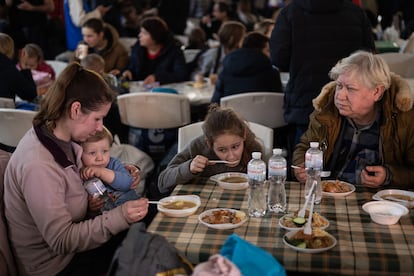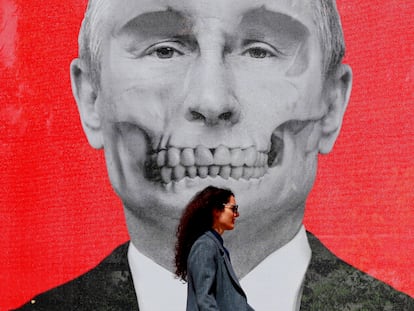No food, medicine or supplies: The horror story of Azovstal survivors
For the first time, a humanitarian convoy managed to leave the steel plant in Mariupol, which has been besieged and bombed by Russian troops for weeks


Inna and Dasha Pavlush have just emerged from hell. They spent the last two months without seeing the light of day, sheltering in the tunnels and bunkers of the Azovstal steel plant, to escape the constant attacks by Russian forces in the devastated city of Mariupol. Mother and daughter, pale and nervous, on Tuesday managed to reach the city of Zaporizhia, a territory controlled by Ukrainian forces. They traveled with a convoy of around 100 people who were evacuated from the plant, the last pocket of resistance in a city that’s been nearly reduced to rubble and already under Russian control. “It’s a catastrophe, I don’t know what will happen to the people who still haven’t managed to get out,” laments Inna, 43.
The situation in the steel plant, say those who have managed to flee, is desperate. There are wounded men among the Ukrainian soldiers who remain inside the factory, where they retreated weeks ago. Food and supplies are low, and so is medicine, explains Inna. Olga Salvina, a retiree who spent two and a half months at the plant, recounts the constant strikes against Azovstal. “They attacked us from all sides,” she said after getting off a white bus upon arrival at the reception complex in Zaporizhia, where the group was received by Deputy Prime Minister Iryna Vereshchuk, health care personnel, police officers and a bevy of journalists.
The siege of Azovstal, the last outpost of Ukrainian resistance in Mariupol, resumed almost as soon as the evacuees left the plant on Sunday. On Tuesday, the Russian army also launched a powerful attack on the steel mill with artillery and air strikes, according to the Russian Defense Ministry. The Ukrainian forces that remain in the plant along with some 200 civilians, according to calculations by city authorities, said that two people without military affiliation have died and 10 have been wounded in the offensive on Tuesday.
The evacuation of the group – mostly women and girls, some of whom are workers or relatives of workers at the plant – has been complex. The trip ended at a huge shopping center that has been converted into a reception point for displaced people from the southeastern territories of the country under Russian siege and occupation. The journey, explains Nadezhda, 18, would have taken no more than four hours in normal circumstances; instead it lasted almost three days, passing through Russian checkpoints in occupied territories, where the military searched the buses and the passengers, making them get off, checking their documentation and occasionally subjecting them to interrogations. Survivors of the Azovstal odyssey were joined along the way by evacuees from other cities under attack.
Nadezhda arrived at the Azovstal plant on March 2. “I went there because it was the safest place I knew of in the city and it had a shelter,” says this young, long-haired woman, who explains that when the war broke out she was alone in Mariupol. At Azovstal she lived with other people who huddled in the tunnels and bunkers with her, taking turns to eat and sleep in groups. There was no light, except for that coming from a generator that supplied some power. “Mariupol was surrounded and the attackers were getting closer to the plant. We have been trapped there under the bombs for two months, unable to leave because the attacks were constant. When we set foot outside for the first time, we had been in the dark for so long that the sun blinded us,” adds this university student who now plans to join her aunt in Germany. Either that or join the army.
Life in Azovstal has been hard, admits Dasha Pavlush. There was a group of children, and the youngest was just a year and a half. “We spent the day playing hide-and-seek, making paper toys,” she says. Dasha is scared. Her father, who is employed by the steel company, is still inside. “Now I just want to get out of this hell, wash my hair, take a shower,” says the young woman. “It has been very difficult and we still have to process it. We had nothing, no food, and we were too scared to go out for it, but the army brought us supplies and helped us survive in there,” adds Inna.
The operation to rescue the first group of civilians from Azovstal was achieved after a number of failed attempts and only after the UN and the International Red Cross led the agreement to evacuate the bunkers. The steel plant has been under sustained attack by the forces of Vladimir Putin, who seeks to overthrow the resistance of this industrial area and claim total control of the port city on the Sea of Azov. Mariupol is symbolic for the Kremlin, which failed to break it in 2014, at the start of the Donbas war. In that conflict, Moscow relied on the pro-Russian separatists through whom it now controls part of the Donetsk and Luhansk regions of eastern Ukraine. Mariupol and its steel plant is the last element that Russia lacks to consolidate the corridor uniting the Ukrainian peninsula of Crimea - illegally annexed in 2014 - with the Donbas.
With expectant looks and worn-out faces, the evacuees of Azovstal spilled from the buses and onto a large white tent where volunteers, UN staff and organizations such as Doctors Without Borders provided them with first aid, a hot meal and even clothes and toys. These people left almost everything behind in Mariupol. Now, after the terror, it is time for them to find a life in a country at war that is struggling to assimilate the trickle of displaced people from the areas under Russian occupation, while fighting the Kremlin’s forces in tough battles in the east and south of the country.
Alina Tsibulenko, a steelworks employee, recounts how people at the plant have had to live basically on pasta, bread, oatmeal and occasionally some canned meat. “You cannot imagine the conditions in which we have lived,” she says shakily. The situation worsened on April 7, when the Russian attacks on Azovstal intensified. “The bombs shook the foundations of the bunker.” Wrapped up in a red jacket despite the sunny day, Valentina Sitnikova says she thought no one would remember the refugees at the plant, some 17 families. “We didn’t think anyone knew we were there,” says the 70-year-old woman, who has spent two months in the Azovstal tunnels with her son and 10-year-old granddaughter. Sitnikova promised the child that they would get out no matter what. And so it has been, she says with a sad smile.
The Soviet-era steel plant, founded under Stalin, features a maze of tunnels and bunkers to resist attack. The industrial complex in the southeast of the city, near the port, spreads over 11 square kilometers in an intricate network of warehouses, railways and underground tunnels. Those who remain at the plant, said Mariupol Mayor Vadym Boychenko, are “on the edge of life and death.” There are injured and sick people in there, he noted in an online post. “They are waiting, praying for a rescue.”
Tuesday’s was the first evacuation of the steel plant and one of the last hopes for the people who have been trapped for weeks in the darkness of the plant’s tunnels. The Ukrainian president, Volodimir Zelenskiy, has stated that the government continues to work with the United Nations to evacuate more civilians from Azovstal. His chief of staff, Andriy Yermak, has also suggested that the evacuations could go beyond the civilians hiding in the steel plant. “It’s just the first step. We will continue to get our civilians and troops out of Mariupol,” he said on his Telegram channel.

There is no concrete information on how many people remain in the factory, where Ukrainian soldiers also took refuge, including members of the Azov battalion, an organization with ties to the far right that is now part of the Ukrainian National Guard founded in 2014, at the start of the Donbas war between the Ukrainian troops and Kremlin-backed pro-Russian separatists. This battalion, which the Kremlin’s rhetoric has focused on in a war that it has defined as a “special military operation” to “de-Nazify” Ukraine – a country led by a Jewish president –, gradually lost its founders over time and became a group of special forces with its most symbolic headquarters in Mariupol.
In the devastated port city, a symbol of the Kremlin’s attacks on the civilian population where a few buildings are still standing, about 100,000 people remain of the 450,000 that the once prosperous city was home to, according to estimates by local authorities. From there, refugees continue to arrive in Zaporizhia, now converted into a reception center for those fleeing the city and from other places now under attack or under Russian control – small groups of cars, packed to the brim, often with the windows broken by the hard journey or by shrapnel.
Their stories about the city are similar. “Mariupol no longer exists, at least the Mariupol we knew,” laments Mariana Kaplum, a 44-year-old economist who managed to get to a tent for displaced people along with her husband, their two young children and her parents. Kaplum and her family had been sheltering from the bombs since mid-April at their countryhouse on the outskirts of the city. “Now they’re not bombing there, the city is more or less calm. But they are attacking Azovstal with planes,” she explains inside the parking lot of the reception center, while Lev, her five-year-old son, runs around nervously.
Tu suscripción se está usando en otro dispositivo
¿Quieres añadir otro usuario a tu suscripción?
Si continúas leyendo en este dispositivo, no se podrá leer en el otro.
FlechaTu suscripción se está usando en otro dispositivo y solo puedes acceder a EL PAÍS desde un dispositivo a la vez.
Si quieres compartir tu cuenta, cambia tu suscripción a la modalidad Premium, así podrás añadir otro usuario. Cada uno accederá con su propia cuenta de email, lo que os permitirá personalizar vuestra experiencia en EL PAÍS.
¿Tienes una suscripción de empresa? Accede aquí para contratar más cuentas.
En el caso de no saber quién está usando tu cuenta, te recomendamos cambiar tu contraseña aquí.
Si decides continuar compartiendo tu cuenta, este mensaje se mostrará en tu dispositivo y en el de la otra persona que está usando tu cuenta de forma indefinida, afectando a tu experiencia de lectura. Puedes consultar aquí los términos y condiciones de la suscripción digital.
More information
Últimas noticias
Aquilino Gonell, former Capitol sergeant: ‘If it hadn’t been for the police, the US would be a dictatorship’
A hybrid building: Soccer pitch, housing, and a shopping mall
Europe urges Trump to respect Greenland following annexation threats
Science seeks keys to human longevity in the genetic mixing of Brazilian supercentenarians
Most viewed
- Alain Aspect, Nobel laureate in physics: ‘Einstein was so smart that he would have had to recognize quantum entanglement’
- Mexico’s missing people crisis casts a shadow over World Cup venue
- Why oil has been at the center of Venezuela-US conflicts for decades
- Trump clarifies who is ultimately in charge in Venezuela: ‘Me’
- Mexico seeks to shore up its defenses following US incursion in Venezuela










































